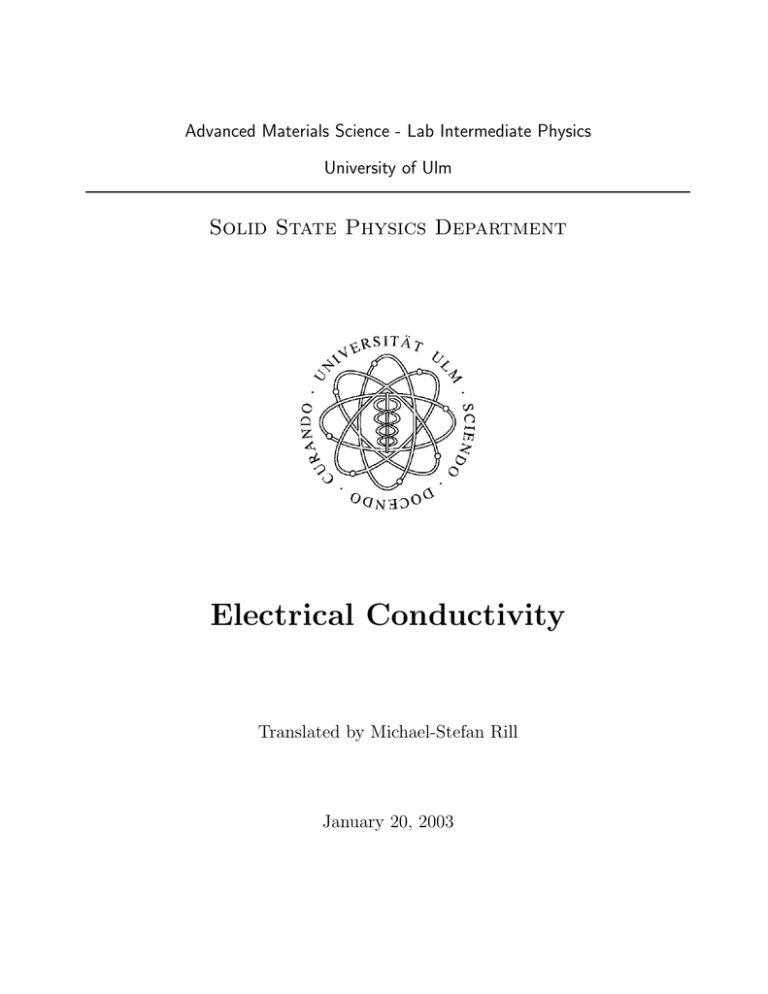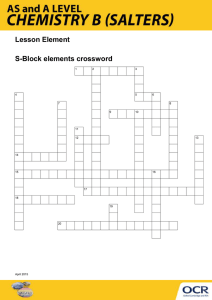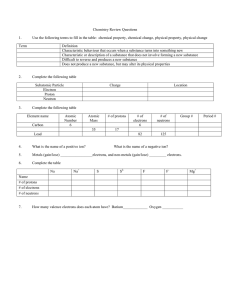Electrical Conductivity
advertisement

Advanced Materials Science - Lab Intermediate Physics University of Ulm Solid State Physics Department Electrical Conductivity Translated by Michael-Stefan Rill January 20, 2003 CONTENTS 1 Contents 1 Introduction 2 2 Basic concepts 2.1 Crystalline metals . 2.2 Semiconductors . . 2.3 Superconductors . 2.4 Amorphous metals . . . . 2 2 3 4 5 3 Experimental setup 3.1 The cryostat . . . . . . . . . . . . . . . . . . . . . . . . . . . . . . . . . . . . . . 3.2 Liquid helium . . . . . . . . . . . . . . . . . . . . . . . . . . . . . . . . . . . . . 3.3 Temperature controller . . . . . . . . . . . . . . . . . . . . . . . . . . . . . . . . 5 6 7 7 4 Tasks 7 5 Important Note 7 . . . . . . . . . . . . . . . . . . . . . . . . . . . . . . . . . . . . . . . . . . . . . . . . . . . . . . . . . . . . . . . . . . . . . . . . . . . . . . . . . . . . . . . . . . . . . . . . . . . . . . . . . . . . . . . . . . . . . . . . . . . . . . . . . . . . 1 INTRODUCTION 1 2 Introduction The electrical conductivity of solids shows – among other properties depending on temperature – very interesting effects, which can be used technically, too. In this course you will get an overview over various materials revealing different temperature dependencies of their electrical conductivitiy. Practically, you will determine the electrical resistivity of various samples as function of temperature. The experimental setup enables you to measure all samples simultaneously over a large temperature range. This seems to be very efficient, because the coolant (liquid helium) used to achieve low temperatures (≈ 4K) requires a complex equipment. Temperature control and data aquisition are handled by means of a computer system. This allows you to write all data to a hard drive giving you the opportunity to easily perform data processing on any computer (you can use, e.g., the system provided by the practical). 2 Basic concepts This section only gives a short outline of some basic models for the electrical conductivity. More detailed aspects as well as an accurate quantum-mechanical derivation for crystalline metals, semiconductors, superconductors, and disordered metals can be found in the literature (e.g.[1] [2], [3]. 2.1 Crystalline metals The conductivity of crystalline simple metals can be described using the model originally proposed by Drude and Lorentz. This model assumes that each atom allows its valence electrons to travel through the solid (the so called conduction electrons). This leads to a high charge-carrier density (1023 electrons per cm3 )which can be treated as a free electron gas. Within the Drude theory the electrical resistance results from scattering processes of the electrons while travelling through the solid. Here the distance, over which an electron can move on average without any collision, will be denoted as “inelastic mean free path”. In an ideal crystal these collisions are caused by thermally induced collective vibrations of the atoms (phonons). This leads to an increase of the electrical resistance with rising temperature, caused by an increasing amplitude of the lattice vibrations (phonon scattering). Due to these considerations the resistivity of an ideal crystal will disappear at zero temperature (T = 0K). Because, in a real crystal, we always find imperfections like defects, impurities, grain boundaries, the resistivity at zero temperature does not vanish but reaches a finite (non-zero) value the so-called . This value is often found to be temperature independent allowing to describe the total resistance as the superposition of two terms: ρ = ρ0 + ρ(T ). At higher temperatures the temperature-dependent part ρ(T ) approaches a linear behaviour. The platinum sample used in the experiment is a polycrystalline specimen. This means, that crystallites ranging in size from typically 10nm to 100nm are present. The individual crystallites are randomly oriented, separated from each other by so called grain boundaries. The latter act 2 BASIC CONCEPTS 3 as additional scattering centers for electrons and therefore contribute to the total resistivity (grain boundary scattering). In the case of samples whose dimensions are large as compared to the inelastic mean free path of the conduction electrons, the resistivity mainly results from scattering at phonons, grain boundaries and impurities. For very thin films (thickness of the order of the inelastic mean free path within the corresponding bulk material) additional contributions arise from an increased scattering at the sample surface (“size”-effects). Quantum-mechanics allows to accurately calculate the behaviour of the electrons by means of the Schrödinger equation. Taking into account that electrons are described by means of the Fermi-Dirac distribution function, the temperature dependent contribution to the resistivity can be determined. This again leads to a linear behaviour of the resistivity at higher temperatures but to a T 5 dependence at low temperatures described by the Bloch-Grüneisen equation: ρ(T ) = A T ΘD 5 Z 0 Θ T x5 dx (ex − 1)(1 − e−x ) (1) where A is a material parameter and ΘD the Debye temperature. The following relations can be used Θ 2 Θ for T < 10 ρ(T ) ∼ T for T > ρ(T ) ∼ T 5 (2) (3) Hence for platinum (ΘD,P t = 229K) a linear resistivity can be expected at room temperature < and a T 5 -behaviour can be expected for temperatures T ∼ 20K. 2.2 Semiconductors The conductivity of semiconductors can be understood within the energy band model. At T = 0K the valence band is completely filled and the conduction band is left empty. Hence, no free charge carriers are available, which can be accelerated by an applied electrical field. Thus, at zero temperature, semiconductors are insulators. At finite temperature, electrons can be excited from the valence band to the conduction band by absorption of thermal energy, now being able to be accelerated by an external electrical field. At the same time, electrons missing in the valence band by excitation of electrons to the conduction band can act a positive charges (hole states) which also contribute to the total conductivity. As compared to metals, for semiconductors the density N of free charge carriers shows a distinct dependence on temperature: with rising T the density of electrons in the conduction band (correspondingly: holes in the valence band) increases exponentially (why?). In order to determine the total conductivity the mobility of different types of charge carriers (electrons, holes) must be considered, which can be different from each other. In the case of polycrystalline carbon one finally obtains for the conductivity 2 BASIC CONCEPTS 4 E − 2 kgapT σ(T ) ∼ e (4) B with Egab representing the activation energy and kB the Boltzmann constant. 2.3 Superconductors Zero resistivity below a critical temperature (but still at finite temperatures!) in the superconducting metals is explained by the occupation of the same quantum mechanical state by a macroscopic amount of charge carriers (BCS theory; Bardeen, Cooper and Schrieffer got the Nobel price for this model). Because electrons as fermions have to fulfill the Pauli exclusion principle they are not allowed to occupy the same quantum mechanical state. To overcome this problem, Bardeen, Cooper and Schrieffer proposed that two single electrons (fermions) can couple to a pair (Cooper-pair) below a critical temperature which behaves like a boson and, therefore, can occupy the ground state together with other Cooper-pairs. The coupling is mediated by phonons (lattice distortions)as illustrated in figures 1 and 2 within a simple mechanical model by two spheres on a membrane: The distortion of the membrane represents a phonon, the sphere reflects an electron. Two electrons can form a Cooper pair, since it can be energetically more favorable, if two electrons interact over the same lattice distortion, as if the electrons distort the crystal lattice by two separated phonons. From the interaction with the same phonon an attractive interaction between the two contributing electrons may result, which leads to a coupling of these electrons. The formation of Cooper pairs is enabled by electron phonon interaction). Figure 1: Attraction of spheres on a flexible membrane. The configuration a is unstable and changes into b To repeat: While electrons as spin 12 -particles must follow the Fermi Dirac distribution function 1 fF D (ε, T ) = exp ε−εF kB T (5) +1 and thus fulfill the Pauli exclusion principle, Cooper pairs as particles with whole-numbered spins are bosons and follow the Bose-Einstein statistics 1 fBE (ε, T ) = exp ~ω kB T (6) −1 2 BASIC CONCEPTS 5 Figure 2: Distortion of the lattice of the atomic core by electrons This distribution function enables the macroscopic occupation of the same quantum state, in which transport quantities e.g. the resistivity or the thermoelectric power disappear. Above the transition temperature TC the Cooper pairs are broken by thermal excitation kB T . Therefore, by exceeding the transition temperature during annealing, the superconducting phase (the Cooper pairs) will disappear and ”normal” electrons will carry the electrical current. 2.4 Amorphous metals Amorphous or glassy metals (typically alloys) generally show resistivities which are about one to two orders of magnitude larger than the values known for their crystalline counterparts. These metals often show a nearly temperature-independent resistivity, which is dominated by electron mean free paths of the order of the interatomic distance. Thus, electron scattering at the disordered atomic structure exceeds the scattering induced by phonons. Amorphous metals can show both, small positive as well small negative temperature coefficaints for the resistivity, respectively. While a small increase in resistivity with temperature can easily be understood by means of an increasing scattering induced by phonons, the negative temperature coefficient can only be understood by means of the Ziman formula [3] Z 2kF 3π N 1 Q3 S(Q, T )|u(Q)|2 dQ (7) ρ= 2 e ~vF 2 V 4kF 4 0 Here vF is the velocity of electrons with Fermi momentum, N is the charge-carrier density. kF V is the Fermi momentum, Q the momentum transfer caused by scattering processes. S(Q, T ) is the structure factor and |u(Q)|2 the matrix element of the scattering process. Details of the latter phenomenon will be explained be your adviser! 3 EXPERIMENTAL SETUP 3 6 Experimental setup The experimental setup (see fig. 3) mainly consists of four components: Cryostat, samples, control unit and recording device. The main components are described in more detail in the following subsections. Figure 3: Schematic sketch of the experimental setup 3.1 The cryostat The cryostat (gr. cryo: low temperature; gr. statos: maintain, retain) is a container, which is used for thermal isolation to achieve low-temperature. The setup is divided into the following parts • Vacuum isolation • Liquid nitrogen cooling shield (TS = 77.3K) 4 TASKS 7 • Second vacuum isolation • Reservoir for liquid helium (the actual refrigerant) • Sample zone 3.2 Temperature controller The temperature controlling device offers a comfortable possibility to easily vary the sample temperature. Using a silicon diode (range: 1.4K to 475K) which is in good thermal contact with the sample holder, the controller repeatedly measures the actual sample temperature. In case of any deviation from the desired temperature the controller adjusts the value of a heater current (heat transfer to the sample holder). On the other hand, there is a constant cooling rate provided by the continuous evaporation of liquid Helium (heat transfer from the sample holder). Since there is constant cooling but variable heating, the controller can adjust any desired temperature of the sample. 4 Tasks • Measure the resistivities of Pt, Cu60 Ni40 , carbon, a-FeB, and MgB2 between 4 and 90K. • Discuss the different phenomena leading to the observed dependencies of the resistivity on temperature. • Determine the transition temperature TC of the superconducting sample. 5 Important Note ATTENTION: ALL MANIPULATIONS OF THE VACUUM SYSTEM/ COOLING SYSTEM HAVE TO BE EXPLAINED BY YOUR ADVISER BEFORE YOU ARE ALLOWED TO CHANGE ANYTHING !! References [1] C. Kittel, Introduction to Solid State Physics. [2] W. Buckel, Superconductivity [3] J. M. Ziman, Models of disorder. REFERENCES 8 Figure 4: Scetch of the cryostat.




